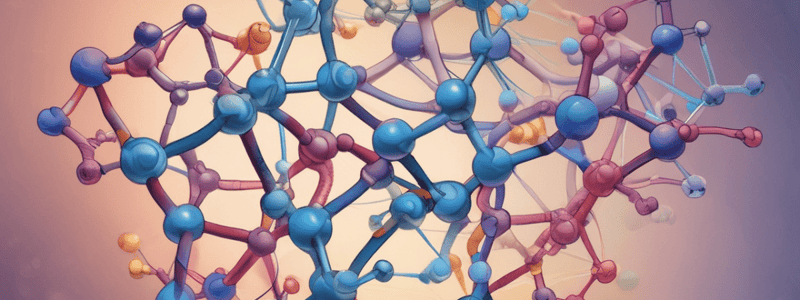Podcast
Questions and Answers
What is the main difference between the 20 universal structural amino acids?
What is the main difference between the 20 universal structural amino acids?
- Their R-group attached to the α-carbon (correct)
- Their role in protein folding
- Their molecular weight
- Their ionization state at physiological pH
What is the functional importance of amino acid side chains?
What is the functional importance of amino acid side chains?
- They are involved in DNA replication
- They define the properties and function of the amino acid (correct)
- They are responsible for protein folding
- They determine the molecular weight of the amino acid
What is the nature of the peptide bond between amino acids?
What is the nature of the peptide bond between amino acids?
- A covalent bond formed through the condensation of amino and carboxyl groups (correct)
- A disulphide bond formed through oxidation
- An ionic bond formed through electrostatic attraction
- A non-covalent bond formed through hydrogen bonding
What is the role of hydrogen bonds in protein structure?
What is the role of hydrogen bonds in protein structure?
What is the main structural feature of an α-helix?
What is the main structural feature of an α-helix?
What is the result of defects in amino acid metabolism?
What is the result of defects in amino acid metabolism?
What is the primary determinant of protein conformation?
What is the primary determinant of protein conformation?
What is the nature of most folded proteins?
What is the nature of most folded proteins?
What is the main difference between selenocysteine and cysteine?
What is the main difference between selenocysteine and cysteine?
What is the role of hydroxyproline in collagen?
What is the role of hydroxyproline in collagen?
What is the result of a defective phenylalanine hydroxylase enzyme?
What is the result of a defective phenylalanine hydroxylase enzyme?
What is the characteristic of the peptide bond that allows for the formation of hydrogen bonds?
What is the characteristic of the peptide bond that allows for the formation of hydrogen bonds?
What is the role of enzymes in the formation of polypeptides?
What is the role of enzymes in the formation of polypeptides?
What is the characteristic of the peptide bond that makes it resistant to rotation?
What is the characteristic of the peptide bond that makes it resistant to rotation?
What is the result of a defective tyrosinase enzyme?
What is the result of a defective tyrosinase enzyme?
What is the role of homocysteine in the synthesis of cysteine?
What is the role of homocysteine in the synthesis of cysteine?
Study Notes
Amino Acids
- Amino acids have an amino group (-NH2) and a carboxylic group (-COOH) attached to the same carbon (α-carbon)
- There are 20 universal structural amino acids encoded in DNA
- Each amino acid has a unique R-group attached to the α-carbon, which defines its properties and function
- At physiological pH, the amino and carboxyl groups are ionized
Essential and Non-Universal Amino Acids
- Some amino acids are essential for the human diet due to the lack of enzymes to synthesize them de novo
- Other amino acids, such as hydroxyproline, selenocysteine, and homocysteine, exist in cells but are not universally encoded in DNA
Peptide Bond
- Amino acids polymerize to form polypeptides (proteins) via the formation of peptide bonds between the alpha amino and alpha carboxylic groups of adjacent amino acids
- The peptide bond is very strong and has some features of a double bond:
- It is shorter than the standard C-N bond length
- There is no rotation
- The R-groups are in the trans configuration
- There is a partial negative charge on the oxygen atom and a partial positive charge on the nitrogen atom
- These partial charges are important in the formation of hydrogen bonds that are key for protein structure
Defects in Amino Acid Metabolism
- Defects in metabolism result in a number of clinical conditions, such as:
- Phenylketonuria (PKU), due to defective phenylalanine hydroxylase
- Albinism, due to defective tyrosinase (tyr → melanin)
Studying That Suits You
Use AI to generate personalized quizzes and flashcards to suit your learning preferences.
Description
This quiz covers the structures of 20 common amino acids, their functional importance, and the nature of peptide bonds. It also explores the main structural features of an α-helix and its role in typical globular and membrane proteins.




